26.10.2023
How NASA Is Protecting Europa Clipper From Space Radiation
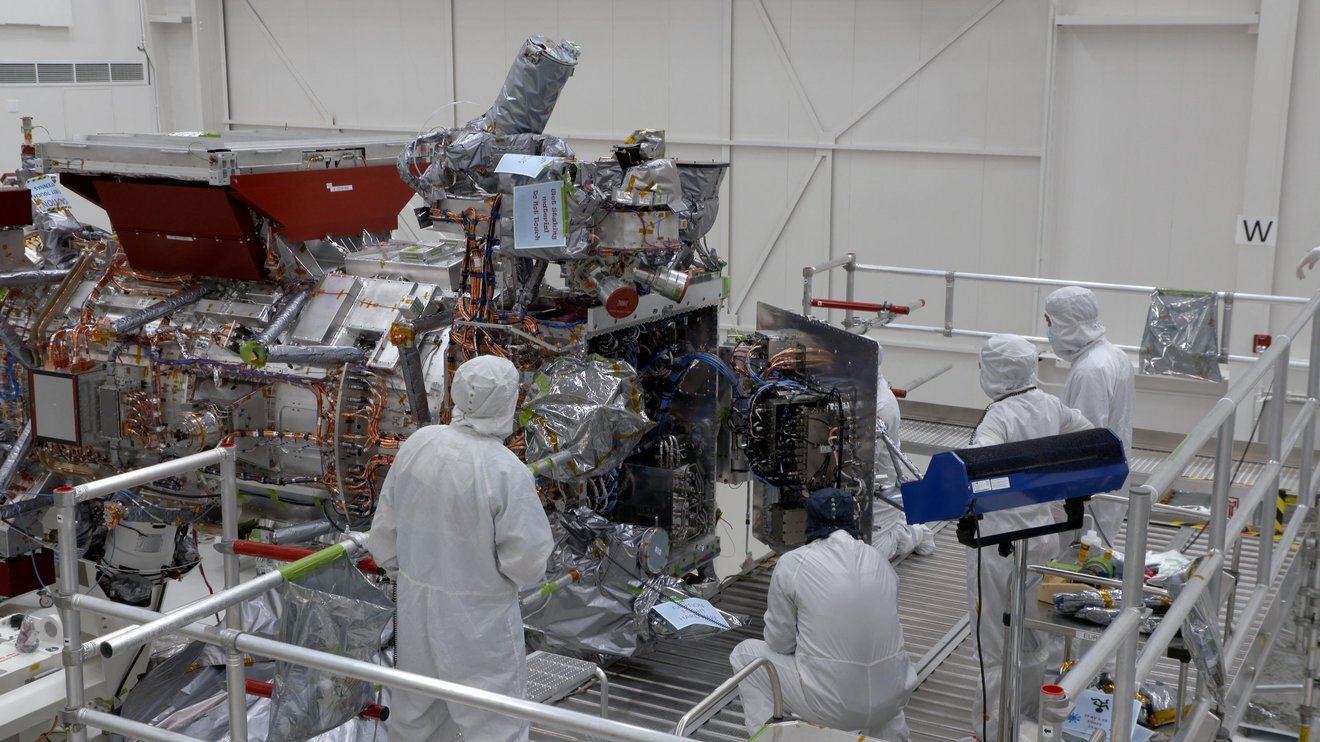
Engineers and technicians are seen closing the vault of NASA’s Europa Clipper in the main clean room of the Spacecraft Assembly Facility at JPL on Oct. 7. The vault will protect the electronics of the spacecraft as it orbits Jupiter.
Credit: NASA/JPL-Caltech
To explore the mysterious ice-encrusted moon Europa, the mission will need to endure bombardment by radiation and high-energy particles surrounding Jupiter.
When NASA’s Europa Clipper begins orbiting Jupiter to investigate whether its ice-encased moon, Europa, has conditions suitable for life, the spacecraft will pass repeatedly through one of the most punishing radiation environments in our solar system.
Hardening the spacecraft against potential damage from that radiation is no easy task. But on Oct. 7, the mission put the final piece of the spacecraft’s “armor” in place when it sealed the vault, a container specially designed to shield Europa Clipper’s sophisticated electronics. The probe is being put together, piece by piece, in the Spacecraft Assembly Facility at NASA’s Jet Propulsion Laboratory in Southern California ahead of its launch in October 2024.
“Closing the vault is a major milestone,” said Kendra Short, Europa Clipper’s deputy flight system manager at JPL. “It means we’ve got everything in there that we have to have in there. We’re ready to button it up.”
Just under a half-inch (1 centimeter) thick, the aluminum vault houses the electronics for the spacecraft’s suite of science instruments. The alternative of shielding each set of electronic parts individually would add cost and weight to the spacecraft.
“The vault is designed to reduce the radiation environment to acceptable levels for most of the electronics,” said JPL’s Insoo Jun, the co-chair of the Europa Clipper Radiation Focus Group and an expert on space radiation.
Punishing Radiation
Jupiter’s gigantic magnetic field is 20,000 times as strong as Earth’s and spins rapidly in time with the planet’s 10-hour rotation period. This field captures and accelerates charged particles from Jupiter’s space environment to create powerful radiation belts. The radiation is a constant, physical presence – a kind of space weather – bombarding everything in its sphere of influence with damaging particles.
“Jupiter has the most intense radiation environment other than the Sun in the solar system,” Jun said. “The radiation environment is affecting every aspect of the mission.”
That’s why when the spacecraft arrives at Jupiter in 2030, Europa Clipper won’t simply park in orbit around Europa. Instead, like some previous spacecraft that studied the Jovian system, it will make a wide-ranging orbit of Jupiter itself to move away from the planet and its harsh radiation as much as possible. During those looping orbits of the planet, the spacecraft will fly past Europa nearly 50 times to gather scientific data.
The radiation is so intense that scientists believe it modifies the surface of Europa, causing visible color changes, said Tom Nordheim, a planetary scientist at JPL who specializes in icy outer moons – Europa as well as Saturn’s Enceladus.
“Radiation on the surface of Europa is a major geologic modification process,” Nordheim said. “When you look at Europa – you know, the reddish-brown color – scientists have shown that this is consistent with radiation processing.”
Chaotic Icescape
So even as engineers work to keep radiation out of Europa Clipper, scientists like Nordheim and Jun hope to use the space probe to study it.
“With a dedicated radiation monitoring unit, and using opportunistic radiation data from its instruments, Europa Clipper will help reveal the unique and challenging radiation environment at Jupiter,” Jun said.
Nordheim zeroes in on Europa’s “chaos terrain,” areas where blocks of surface material appear to have broken apart, rotated, and moved into new positions, in many cases preserving preexisting linear fracture patterns.
Deep beneath the moon’s icy surface is a vast liquid-water ocean, scientists believe, that could offer a habitable environment for life. Some areas of Europa’s surface show evidence of material transport from the subsurface to the surface. “We need to understand the context of how radiation modified that material,” Nordheim said. “It can alter the chemical makeup of the material.”
The Power of Heat
Because Europa’s ocean is locked inside an envelope of ice, any possible life forms would not be able to rely directly on the Sun for energy, as plants do on Earth. Instead, they’d need an alternative energy source, such as heat or chemical energy. Radiation raining down on Europa’s surface could help provide such a source by creating oxidants, such as oxygen or hydrogen peroxide, as the radiation interacts with the surface ice layer.
Over time, these oxidants could be transported from the surface to the interior ocean. “The surface could be a window into the subsurface,” Nordheim said. A better understanding of such processes could provide a key to unlock more of the Jupiter system’s secrets, he added: “Radiation is one of the things that makes Europa so interesting. It’s part of the story.”
More About the Mission
Europa Clipper’s main science goal is to determine whether there are places below Jupiter’s icy moon, Europa, that could support life. The mission’s three main science objectives are to determine the thickness of the moon’s icy shell and its surface interactions with the ocean below, to investigate its composition, and to characterize its geology. The mission’s detailed exploration of Europa will help scientists better understand the astrobiological potential for habitable worlds beyond our planet.
Quelle: NASA
----
Update: 1.02.2024
.
Poised for Science: NASA’s Europa Clipper Instruments Are All Aboard
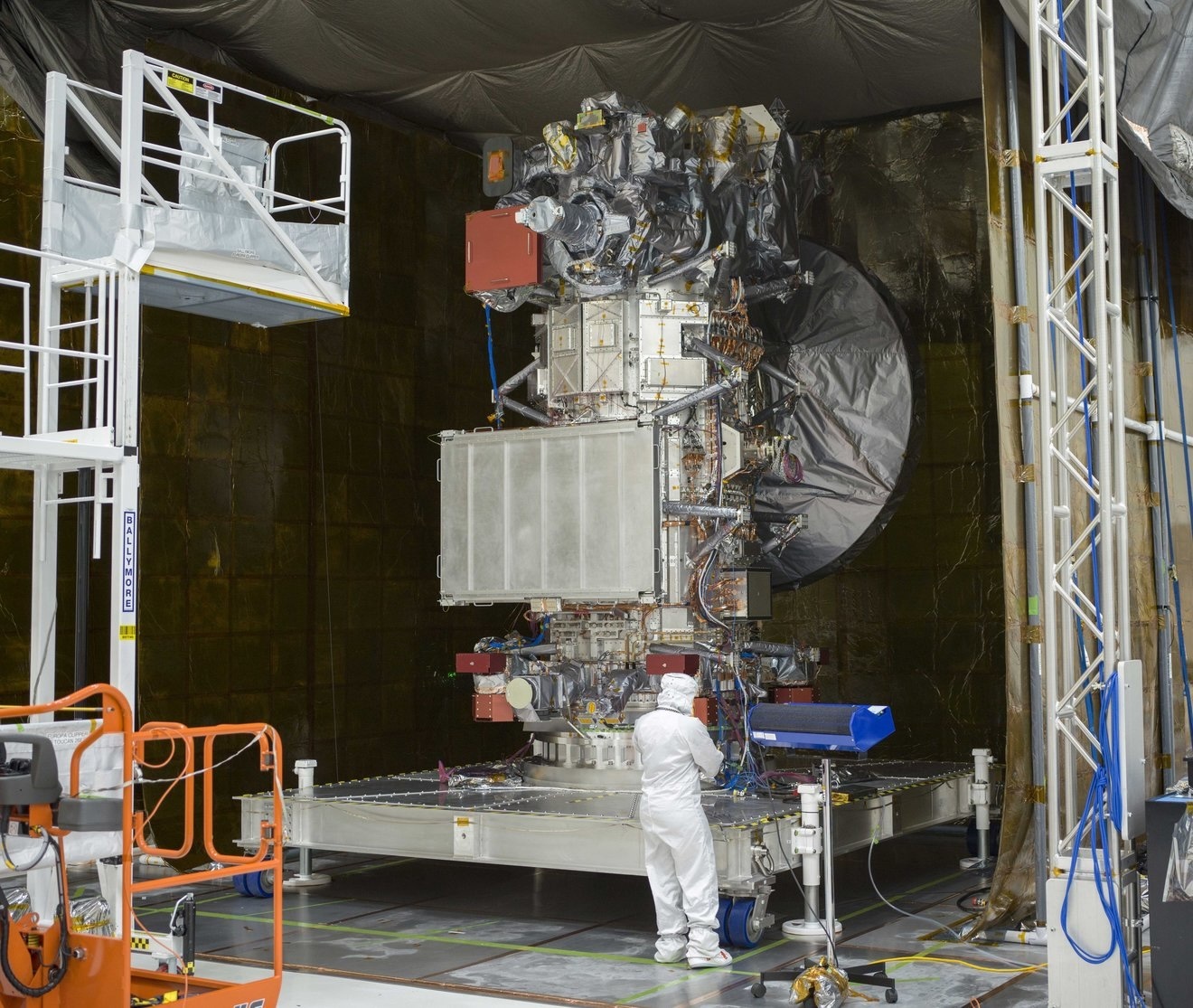
NASA’s Europa Clipper, with all of its instruments installed, is visible in the clean room of High Bay 1 at the agency’s Jet Propulsion Laboratory on Jan. 19. The tent around the spacecraft was erected to support electromagnetic testing.
Credit: NASA/JPL-Caltech
The science performed by the complex suite of instruments recently added to the spacecraft will reveal whether Jupiter’s moon Europa has conditions that could support life.
With less than nine months remaining in the countdown to launch, NASA’s Europa Clipper mission has passed a major milestone: Its science instruments have been added to the massive spacecraft, which is being assembled at the agency’s Jet Propulsion Laboratory in Southern California.
Set to launch from Kennedy Space Center in Florida in October, the spacecraft will head to Jupiter’s ice-encased moon Europa, where a salty ocean beneath the frozen surface may hold conditions suitable for life. Europa Clipper won’t be landing; rather, after arriving at the Jupiter system in 2030, the spacecraft will orbit Jupiter for four years, performing 49 flybys of Europa and using its powerful suite of nine science instruments to investigate the moon’s potential as a habitable environment.
“The instruments work together hand in hand to answer our most pressing questions about Europa,” said JPL’s Robert Pappalardo, the mission’s project scientist. “We will learn what makes Europa tick, from its core and rocky interior to its ocean and ice shell to its very thin atmosphere and the surrounding space environment.”
The hallmark of Europa Clipper’s science investigation is how all of the instruments will work in sync while collecting data to accomplish the mission’s science objectives. During each flyby, the fully array of instruments will gather measurements and images that will be layered together to paint the full picture of Europa.
“The science is better if we obtain the observations at the same time,” Pappalardo said. “What we’re striving for is integration, so that at any point we are using all the instruments to study Europa at once and there is no need to have to trade off among them.”
From the Inside Out
By studying the environment around Europa, scientists will learn more about the moon’s interior. The spacecraft carries a magnetometer to measure the magnetic field around the moon. That data will be key to understanding the ocean, because the field is created, or induced, by the electrical conductivity of the ocean’s saltwater as Europa moves through Jupiter’s strong magnetic field. Working in tandem with the magnetometer is an instrument that will analyze the plasma (charged particles) around Europa, which can distort magnetic fields. Together, they’ll ensure the most accurate measurements possible.
What the mission discovers about Europa’s atmosphere will also lend insights into the moon’s surface and interior. While the atmosphere is faint, with only 100 billionth the pressure of Earth’s atmosphere, scientists expect that it holds a trove of clues about the moon. They have evidence from space- and ground-based telescopes that there may be plumes of water vapor venting from beneath the moon’s surface, and observations from past missions suggest that ice and dust particles are being ejected into space by micrometeorite impacts.
Three instruments will help investigate the atmosphere and its associated particles: A mass spectrometer will analyze gases, a surface dust analyzer will examine dust, and a spectrograph will collect ultraviolet light to search for plumes and identify how the properties of the dynamic atmosphere change over time.
All the while, Europa Clipper’s cameras will be taking wide- and narrow-angle pictures of the surface, providing the first high-resolution global map of Europa. Stereoscopic, color images will reveal any changes in the surface from geologic activity. A separate imager that measures temperatures will help scientists identify warmer regions where water or recent ice deposits may be near the surface.
An imaging spectrometer will map the ices, salts, and organic molecules on the moon’s surface. The sophisticated set of imagers will also support the full instrument suite by collecting visuals that will provide context for the set of data collected.
Of course, scientists also need a better understanding of the ice shell itself. Estimated to be about 10 to 15 miles (15 to 25 kilometers) thick, this outer casing may be geologically active, which could result in the fracture patterns that are visible at the surface. Using the radar instrument, the mission will study the ice shell, including searching for water within and beneath it. (The instrument’s electronics are now aboard the spacecraft, while its antennas will be mounted to the spacecraft’s solar arrays at Kennedy later this year.)
Finally, there’s Europa’s interior structure. To learn more about it, scientists will measure the moon’s gravitational field at various points in its orbit around Jupiter. Observing how signals transmitted from the spacecraft are tugged on by Europa’s gravity can tell the team more about the moon’s interior. Scientists will use the spacecraft’s telecommunications equipment for this science investigation.
With all nine instruments and the telecommunications system aboard the spacecraft, the mission team has begun testing the complete spacecraft for the first time. Once Europa Clipper is fully tested, the team will ship the craft to Kennedy in preparation for launch on a SpaceX Falcon Heavy rocket.
More About the Mission
Europa Clipper’s main science goal is to determine whether there are places below Jupiter’s icy moon, Europa, that could support life. The mission’s three main science objectives are to determine the thickness of the moon’s icy shell and its surface interactions with the ocean below, to investigate its composition, and to characterize its geology. The mission’s detailed exploration of Europa will help scientists better understand the astrobiological potential for habitable worlds beyond our planet.
Quelle: NASA
----
Update: 29.03.2024
.
NASA’s Europa Clipper Survives and Thrives in ‘Outer Space’ on Earth
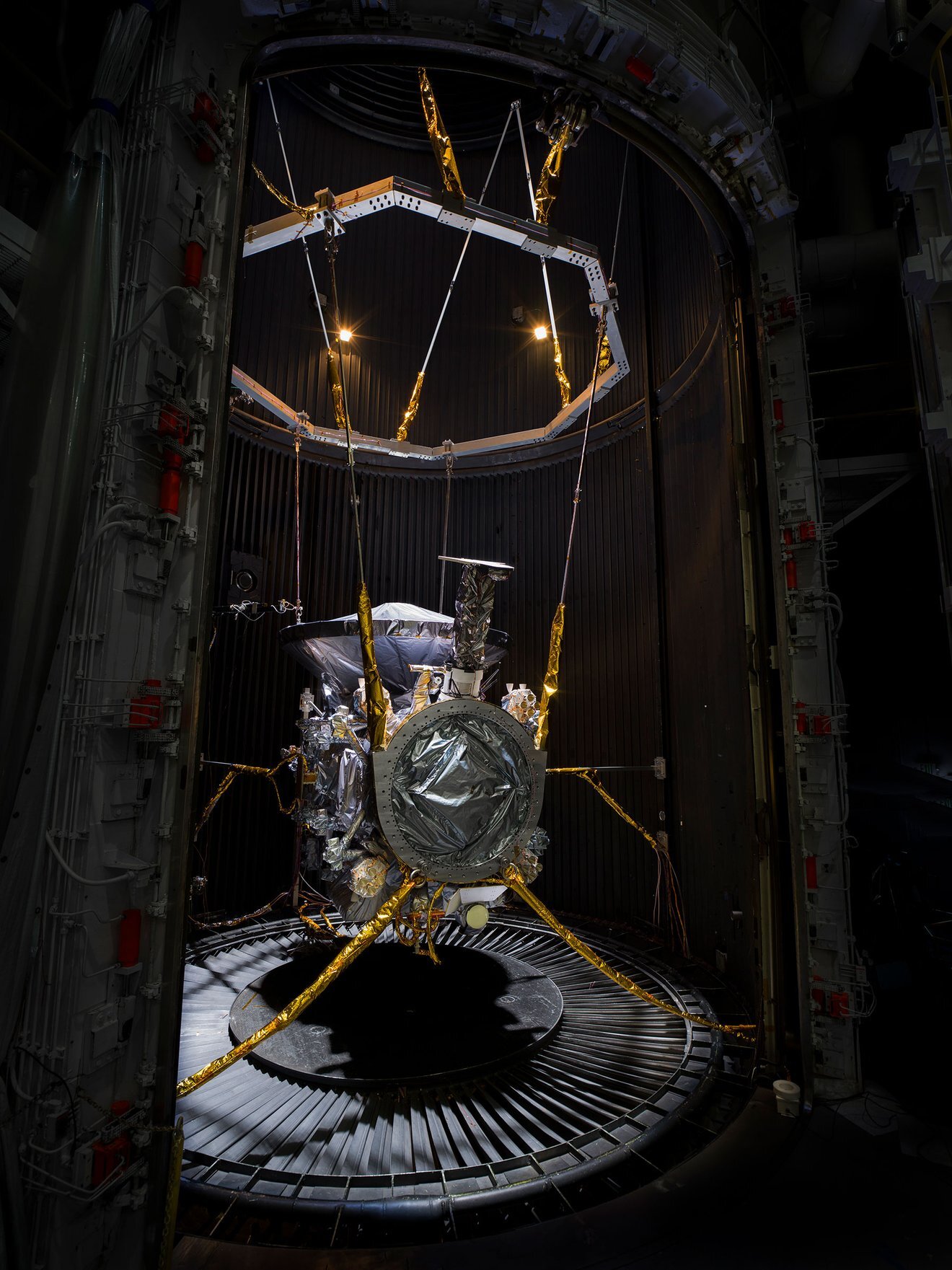
Europa Clipper is seen in the 25-Foot Space Simulator at JPL in February, before the start of thermal vacuum testing. A battery of tests ensures that the NASA spacecraft can withstand the extreme hot, cold, and airless environment of space.
Credit: NASA/JPL-Caltech
A gantlet of tests prepared the spacecraft for its challenging trip to the Jupiter system, where it will explore the icy moon Europa and its subsurface ocean.
In less than six months, NASA is set to launch Europa Clipper on a 1.6-billion-mile (2.6-billion-kilometer) voyage to Jupiter’s ocean moon Europa. From the wild vibrations of the rocket ride to the intense heat and cold of space to the punishing radiation of Jupiter, it will be a journey of extremes. The spacecraft was recently put through a series of hard-core tests at the agency’s Jet Propulsion Laboratory in Southern California to ensure it’s up to the challenge.
Called environmental testing, the battery of trials simulates the environment that the spacecraft will face, subjecting it to shaking, chilling, airlessness, electromagnetic fields, and more.
“These were the last big tests to find any flaws,” said JPL’s Jordan Evans, the mission’s project manager. “Our engineers executed a well-designed and challenging set of tests that put the system through its paces. What we found is that the spacecraft can handle the environments that it will see during and after launch. The system performed very well and operates as expected.”
The Gantlet
The most recent environmental test for Europa Clipper was also one of the most elaborate, requiring 16 days to complete. The spacecraft is the largest NASA has ever built for a planetary mission and one of the largest ever to squeeze into JPL’s historic 85-foot-tall, 25-foot-wide (26-meter-by-8-meter) thermal vacuum chamber (TVAC). Known as the 25-foot Space Simulator, the chamber creates a near-perfect vacuum inside to mimic the airless environment of space.
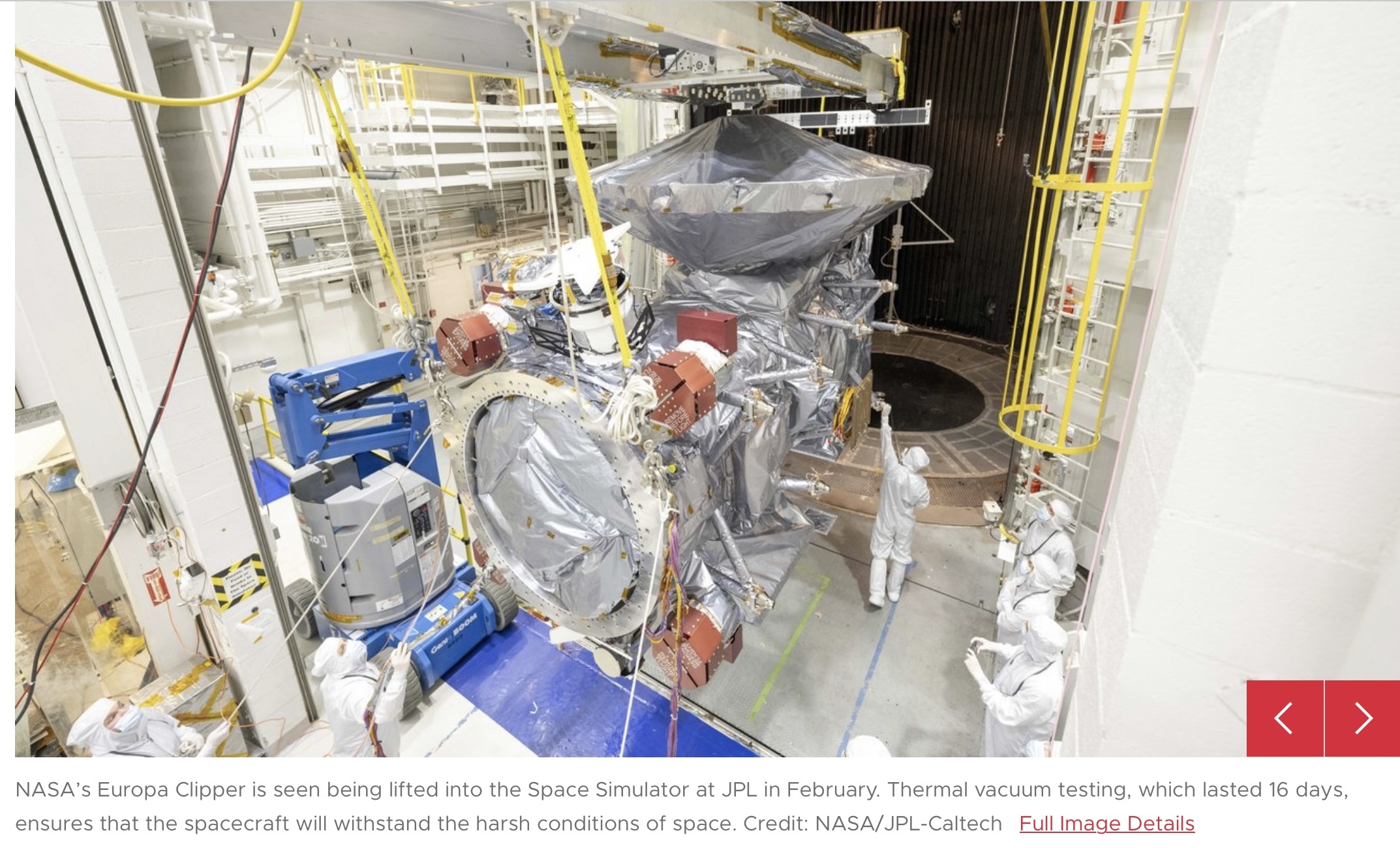
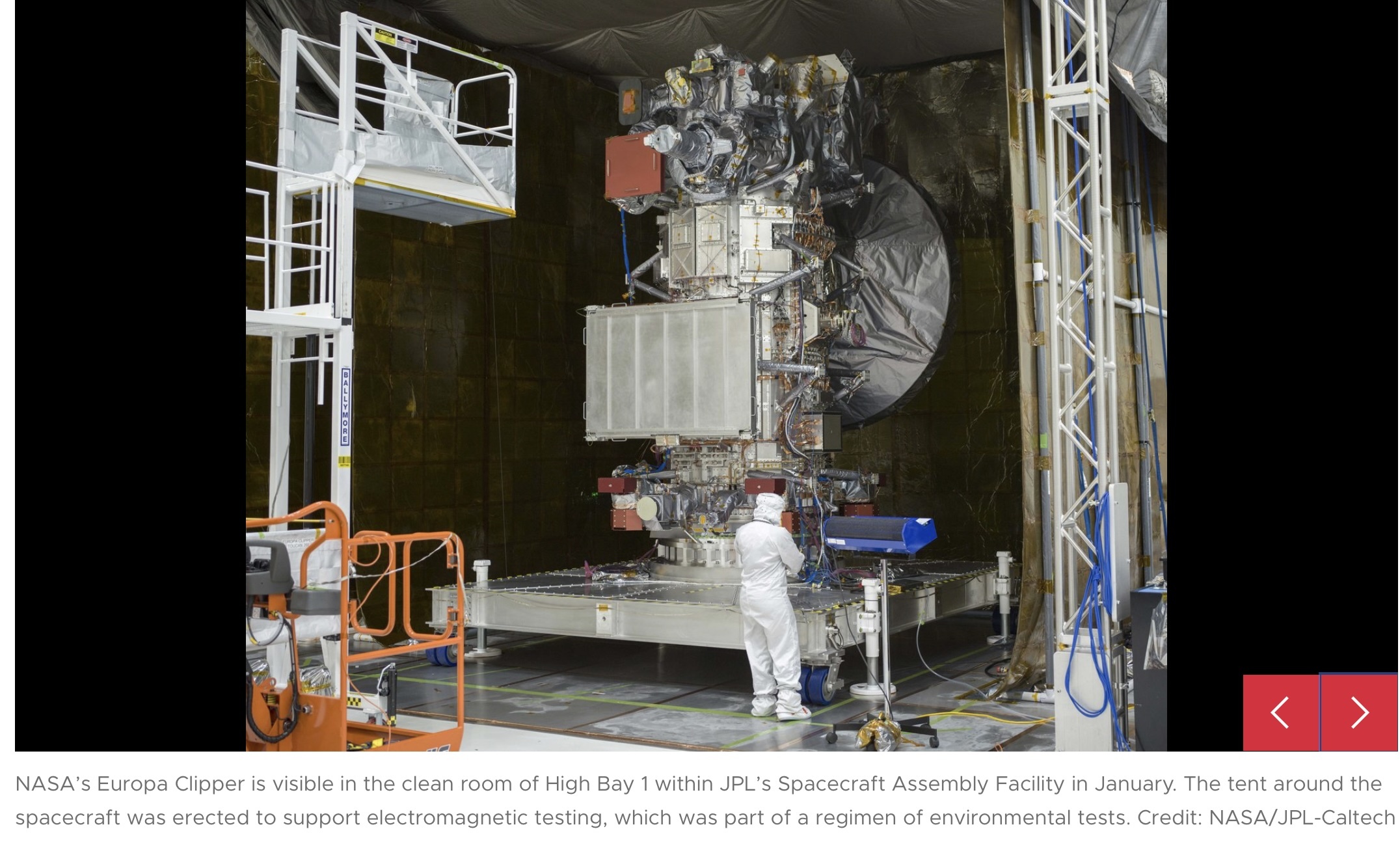
To simulate the journey away from the Sun, the lamps were dimmed and liquid nitrogen filled tubes in the chamber walls to chill them to temperatures replicating space. The team then gauged whether the spacecraft could warm itself, monitoring it with about 500 temperature sensors, each of which had been attached by hand.
TVAC marked the culmination of environmental testing, which included a regimen of tests to ensure the electrical and magnetic components that make up the spacecraft don’t interfere with one another.
The orbiter also underwent vibration, shock, and acoustics testing. During vibration testing, the spacecraft was shaken repeatedly – up and down and side to side – the same way it will be jostled aboard the SpaceX Falcon Heavy rocket during liftoff. Shock testing involved pyrotechnics to mimic the explosive jolt the spacecraft will get when it separates from the rocket to fly its mission. Finally, acoustic testing ensured that Europa Clipper can withstand the noise of launch, when the rumbling of the rocket is so loud it can damage the spacecraft if it’s not sturdy enough.
“There still is work to be done, but we’re on track for an on-time launch,” Evans said. “And the fact that this testing was so successful is a huge positive and helps us rest more easily.”
Looking to Launch
Later this spring, the spacecraft will be shipped to NASA’s Kennedy Space Center in Florida. There, teams of engineers and technicians will carry out final preparations with eyes on the clock. Europa Clipper’s launch period opens Oct. 10.
After liftoff, the spacecraft will zip toward Mars, and in late February 2025, it will be close enough to use the Red Planet’s gravitational force for added momentum. From there, the solar-powered spacecraft will swing back toward Earth to get another slingshot boost – from our own planet’s gravitational field – in December 2026.
Then it’s on to the outer solar system, where Europa Clipper is set to arrive at Jupiter in 2030. The spacecraft will orbit the gas giant while it flies by Europa 49 times, dipping as close as 16 miles (25 kilometers) from the moon’s surface to gather data with its powerful suite of science instruments. The information gathered will tell scientists more about the moon’s watery interior.
More About the Mission
Europa Clipper’s main science goal is to determine whether there are places below the surface of Jupiter’s icy moon, Europa, that could support life. The mission’s three main science objectives are to determine the thickness of the moon’s icy shell and its surface interactions with the ocean below, to investigate its composition, and to characterize its geology. The mission’s detailed exploration of Europa will help scientists better understand the astrobiological potential for habitable worlds beyond our planet.
Managed by Caltech in Pasadena, California, JPL leads the development of the Europa Clipper mission in partnership with the Johns Hopkins Applied Physics Laboratory (APL) in Laurel, Maryland, for NASA’s Science Mission Directorate in Washington. APL designed the main spacecraft body in collaboration with JPL and NASA’s Goddard Space Flight Center in Greenbelt, Maryland. The Planetary Missions Program Office at NASA’s Marshall Space Flight Center in Huntsville, Alabama, executes program management of the Europa Clipper mission.
Quelle: NASA

